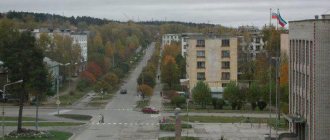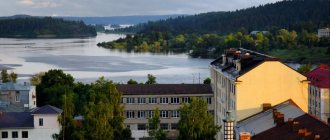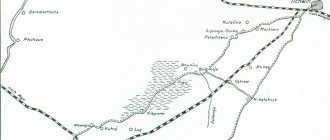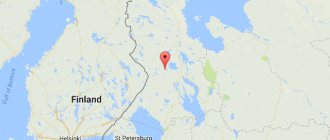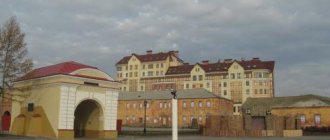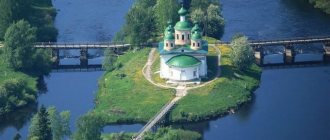Share
Tell
Share
Tweet
Share
“Guberniya Daily” continues the new project “What to do here?”, within the framework of which Evgenia Volunkova and photographer Andrei Myagkov spend weekends in cities and large settlements of our republic. We want to understand how people relax where there seems to be nothing to do. Cafes, discos, parks, clubs, cinemas and libraries. Suoyarvi, Lahdenpohja, Segezha and Pudozh - we will visit everywhere and tell you everything. After Kondopoga, our destination was the city of Segezha.
Brief information
Segezha is located in the central part of Karelia, two hundred and seventy kilometers from Petrozavodsk. The population is about thirty thousand people. The main street is Sovetov Boulevard. A bridge over the railway tracks divides the city into two parts - the Old Town and the Microdistrict. The old town is beautiful, with many cultural sites. And the Microdistrict is like a microdistrict. The heart of the city is the Segezha Pulp and Paper Mill, which is still in relatively good health.
Notes
- (unavailable link). Access date: December 28, 2014.
- ↑. Access date: April 27, 2022.
- ↑ The Great Patriotic War in Karelia: monuments and memorable places. - Petrozavodsk, 2015. - 334 p.: ill.
- . Access date: November 30, 2013.
- . Demoscope Weekly. Access date: September 25, 2013.
- ↑
- . Demoscope Weekly. Access date: September 25, 2013.
- . Demoscope Weekly. Access date: September 25, 2013.
- .
- (2002). Date accessed: May 31, 2022.
- . Access date: May 27, 2016.
- . Access date: January 2, 2014.
- . Federal State Statistics Service. Access date: July 2, 2013.
- . Access date: May 31, 2014.
- . Access date: November 16, 2013.
- . Date accessed: August 2, 2014.
- . Date accessed: August 6, 2015.
- (October 5, 2018). Access date: May 15, 2022.
- (July 31, 2017). Access date: July 31, 2022.
- . Access date: July 25, 2022.
- . Access date: July 31, 2022.
- . Access date: October 17, 2022.
- taking into account the cities of Crimea
- (RAR archive (1.0 MB)). Federal State Statistics Service
. - (unavailable link). Access date: June 8, 2012.
- Karelia: encyclopedia: in 3 volumes / chapter. ed. A. F. Titov. T. 2: K - P. - Petro, 2009. P. 252-464 pp.: ill., map. ISBN 978-5-8430-0125-4 (vol. 2)
- (unavailable link). Access date: June 20, 2011.
Walks
— In my childhood, Segezha was still a city of “boy clans”: districts and even courtyards were hostile against each other. If you accidentally wandered into someone else’s territory, you could easily get a scoreboard,” recalls former Segezha resident Andrei A. “In our yard on the street. Spiridonov, for example, had his own clan. There was a rocking chair in the yard, everyone went there, so they were afraid of us. It was scary to walk into the Old Town in the evening along the paths across the railway tracks. A gang of “redheads” was on duty in the area - red-haired brothers who took money. If you get caught by the “saffron milk cap,” you’re considered lost. Shakes out money and kicks. If you resist, they will beat you.
Another resident of Segezha, Alexey P., also talks about the clans.
“I remember we always developed a whole plan for how to get past the “saffron milk caps”... One evening, we were sneaking back home. There wasn't a lot of money, but it was still a pity. We had almost crossed the bridge when we ran into some boys. I shouted: “Dvorami! We’re leaving through the yards!” and we ran as fast as I’ve ever run. Then they left. And my friends then saw me for a long time and mocked me, shouting: “We’re leaving through the yards!”
Now there are no more clans. In Segezha, even on weekends it is quiet and, it seems, calm.
Once upon a time in Segezha, in the Old Town, there was a notable Park of Culture and Leisure. It could boast a cool, by Karelian standards, “roller coaster” and many other attractions. The whole city, young and old, came here for a walk. Have fun on the carousel, eat ice cream, read a book on a bench... Today all that remains of the park is a children's slide in the shape of an elephant and two yellow giraffes between trees of unknown purpose. The benches are dilapidated, the bushes are overgrown. The only surviving sculpture of a moose cow with a calf at the back is decorated with white zebra stripes. And yet some continue to go to the park. Out of habit or simply because there is nowhere else to go. Someone drinks beer on a bench behind the bushes, hiding away from prying eyes, someone just sits and thinks about something.
Not far from the park, opposite the cinema, there is a good playground. Nearby, despite the bad roads, children rollerblade and ride bicycles. By the way, about the roads. Our guide, Segezhan Artem, told how one day the mayor came out to people and offered to chip in to repair a very bad part of the road. “There is no money,” the mayor admitted. “Let’s do it ourselves!” And people chipped in.
Today, a good place for walking is “lesokulturka” - a forested park area behind the city sports complex. In winter you can ski there, and in summer you can run, walk and feed squirrels. In Soviet times there was even a large swing boat.
People also walk along the green Katanandova Alley. In the center there is a fountain with benches where you can sit. It's just a pity that the fountain doesn't work. Like no other in Segezha.
Segezhan residents also like to hang out near the new station, the architecture of which stands out from the general background. By the way, at the station there is a free toilet, even if the doors don’t close. We saw another toilet, not far from the station, on the main street. For some reason, the booth is located behind a mesh metal fence.
“This is where the janitors store their shovels,” Artem wasn’t joking.
Monastery of the New Martyrs
The indigenous inhabitants of Segezh are very kind and respectful of religion and therefore protect the Temples for which this amazing city is famous. One of these ancient buildings was the Monastery of the New Martyrs. It is no coincidence that the monastery received such a sad name. After all, it was during Stalin’s times that all the clergy were brutally tortured, tortured and exterminated here. People of believers and Orthodox Christians. The area was torn by the groans of the best and most respectable people in Russia, who were disliked by the monstrous authorities of that time. And it is here that the myrrh-streaming icon of the Mother of God is now located, which still mourns the suffering of those who happened to find themselves in the dungeons of the camps founded precisely within the monastery’s holy walls. Now a lot of pilgrims come here to remain silent and honor the memory of those who gave their lives for our happy and peaceful future.
A lot can be said about such a wonderful city as Segezha. But it’s better to see it with your own eyes in order to feel and realize all the amazing secrets and incredible beauties that it has and attracts tourists from all over the world.
Eat and drink
Despite the fact that Segezha residents say that they eat exclusively at home, in my opinion, there are enough places to eat in little Segezha.
Directly opposite the station, in a two-story building that used to be a fish store, there is now a new Panarama bar. When asked why “Panarama” is spelled with an “a,” the waiter explained that they once made a mistake and did not correct it, turning it into a “trick.”
“Panaram” is cozy and has a good view from the window. The menu is varied: from beer and pizza to puree soups and even rolls. About the “panoramic” rolls, local resident Alexey said that he was afraid to eat them - “it’s not clear who rolls them there.” Prices are equal to the capital's average, but they don't bite. We tried the Margherita pizza - it was quite good.
Another place where you can have lunch is the Vyg cafe-bar in the Old Town on Grazhdanskaya Street. Segezhan residents say that the interior there is very nice and the food is delicious. We didn’t go to “Vyg”, but we did look into “Bear’s Corner”. This is a recently opened bar in the Segezha hotel complex on the outskirts of the city. The interior is in the Karelian style, there is a stuffed bear in the corner, and ducks on the ceiling. Lunches, dinners and alcohol - everything is here.
Right there in the complex there is a cafe “Segezha”. You can dine here during the day and dance here at night.
Recently, Sushi City opened in the Microdistrict, on the main street. “There,” said Alexey, “you can eat sushi: the Koreans stand and spin it.” You can buy it to take with you, or you can eat it right there. Prices are the same as in Petrozavodsk.
But the confectionery “Irya”, where Andrei A. ran to get delicious eclairs as a child and where we also headed in the hope of enjoying it, no longer exists. And also, according to our guide Artem, there was a place called “Metso” where they fed very well. Now there's a pharmacy there.
In Segezha one thing is very easily and quickly replaced by another. There was a city bathhouse - it became the Bank of Moscow, and more recently - VTB-24. There was a children's clinic - now a Dixie store, and instead of the Children's World, which half the city once went to, there is now a furniture store.
There are also several kebab shops in the city. One of them is on the road to the Culture Park. And shops that sell pies. For example, opposite the House of Culture, in the square there is a large selection of flour products and there are even a couple of tables to sit and eat. According to Alexey, canteens are popular: the recently opened “People’s Canteen” and those located on the territory of the Segezha Pulp and Paper Mill and LDK.
mass media
In Segezha and in the Segezha region there is a television and radio company called TV-Contact. Since 1992, TV-Kontakt CJSC has been broadcasting on television channel 6 on the basis of a communications license. Under an agreement with the Moscow TVC channel, this channel is rebroadcast on the territory of Segezha.
In accordance with the broadcast network, the television produces and broadcasts its own information programs: “News of Segezha”, “Topic of the Day”, “Power and We”, etc. The audience of the TV channel “TV-Segezha” is the population of the city of Segezha. There is also a television station here that produces the program “Segezha News” and advertisements of its own production.
Since 2009, CJSC TV-Kontakt has been rebroadcasting the radio station Avtoradio on the waves of Radio-Kontakt 104.2 FM in the Segezha region. Radio-Contact broadcasts informational and advertising programs of its own production. Radio-Contact listeners are residents of the Segezha district. In addition, Avtoradio plays on a 150 km section of the Kola highway. Also in Segezha there are radio stations “Russian Radio” and “Europe Plus”.
Since 1946, the regional socio-political newspaper “Doverie” has been published in Segezha (former names were “Stalin’s Way”, then “Leninets”; it received its modern name in 1992). She covers the events that took place in the city and region over the past week. In addition, there is a free advertising and information publication “Segezha Courier”, publication frequency - 2 times a month, circulation - 12,000 copies. Also, from 1941 to 2010, the newspaper “Segezhsky Bumazhnik” was published (the publication was discontinued by the decision of the publication’s founder).
Night life
Calling Segezha’s nightlife vibrant is like calling a giraffe an elephant. And yet it is there. And even in different places.
For example, discos are held in the House of Culture. Now, however, it’s not the season, so I didn’t have a chance to take a look.
You can also dance at the Vyg bar. There is both music and interior - everything is conducive to relaxation. In addition to the table ordering system. Recently, you can only get into Vyg on a Saturday night by booking a table. The cost of the reservation is two thousand rubles. Of course, you then “turn” this money into food and drink, but if you just want a glass of champagne, there’s nothing to do at Vyg.
“In Vyga, scantily clad girls, go-go dancers, have recently started dancing on the bar counter,” said Alexey. “When they first appeared, the men were stunned and shoved money at them. Now we’re used to it, there’s less excitement.
By the way, many people come here late at night to eat after dancing at Segezha (a cafe in the Segezha complex, which at night turns into a bar with a dance floor). The photographer and I decided to relax at Segezha: the disco there lasts until two o’clock in the morning, and it’s quite possible to sit out until the end.
We booked a table by phone - free of charge. They paid one hundred and eighty rubles for entry. By Segezha standards, this is expensive. On regular weekends (not holidays and when foreign DJs don’t come), admission can cost up to one hundred and twenty rubles.
The disco hall is decent, but something is not right about it. “It looks like a dining room,” Alexey helped me figure out. Similar But the service is very friendly and fast - not cafeteria style. The dance floor lighting is good. And some amazing bar that has everything.
“Once a friend from St. Petersburg came to visit me,” says Alexey. - I took him here. And he told the bartender some sophisticated cocktail. And he took it and made it. And served it as it should. The friend was shocked.
The alcohol menu is, however, rich. The eye lingered on the cost of fifty grams of champagne: 27 rubles. That is, the standard hundred is 54 rubles.
According to Alexey, we were lucky. There are a lot of people, mostly young people, because students and guests have not yet managed to go home. Two weeks ago there was a completely different contingent here – more mature and less cheerful.
It was precisely because the young people had not left yet that DJs came from Petrozavodsk. Four people lined up behind the control panel and worked, leaving us to guess which of them was helping whom and with what. The music is a mixture of disco house and pop. Plus the slow ones. Nothing special, but everything is for the people.
In general, all visitors must be given their due: I didn’t see any very drunk or aggressive people. This is an ordinary disco, except perhaps not long. We, however, left before the “end”. By the way, here, on the first floor, we found a bowling alley.
Story
Until the 12th-13th centuries, the main population of the area were the Sami. Later, Karelians and the first Russian settlers from the Novgorod lands appeared.
Russian empire
In 1694, fugitive peasants and participants in the Solovetsky Uprising founded the Vygoretsky Monastery - the “Vygoretsky Abode”. The monastery was located on the Verkhny Vyg River, but some of its monasteries were also located on the banks of the Vygozero.
From the beginning of the 1800s - the Vygozerskaya volost of the Povenets district of the Olonets province. At the beginning of the 20th century, the Vygozersky volost included three peasant societies - Maselga, Vygozersky and Koykinitsky.
S. N. Sokolov, who explored the Povenets district on behalf of the Society of Lovers of Natural History, Anthropology and Ethnography in 1904, described Segezha this way: “This village, if you can call it that... consists of one house, the inhabitant of which is a Korel under the name of Judas, with family. Thanks to the advantageous location of his house on a large rafting river and thanks to the abundance of animals, birds and fish in the surrounding area, as well as water meadows, his family is always provided with everything necessary and does not suffer great need. The only inconvenience of this village is the almost complete absence of roads to it.”
In connection with the construction of the Murmansk railway, which began in 1914, a small station, Segezha, appeared in the Vygozersk volost, among others.
Sport
Segezha has always been a very sporty city. Was. Now people may not have lost interest in sports, but the situation with sports itself is worse than it was fifteen years ago.
“The sports stadium took twenty years to build,” says Andrey A. “We started construction, then froze it.” At some point, they managed to make treadmills with a rubberized coating. And people slowly took them to their dachas. Either dilapidated or unfinished, the stadium stood there for many years. Then the money appeared, and we decided to finish this city long-term construction...
The long-suffering stadium is located next to the Segezha Hotel. And here is the Sports Palace, built by the plant.
“In my childhood, this was perhaps the most popular building in the city,” Andrey recalls. “People went there with their families after work and on weekends. A gym, then a swimming pool... I don’t know if there’s anything left there now?
Left. Both the pool and the gym are open. There are also basketball, football and volleyball courts. Alexey visits there often. He says he likes it. True, as many people as before no longer go to the Sports Palace. Maybe the morals are different?
Also in Segezha, in the building of the Cinema and Youth Center, there is a synthetic ice skating rink. Small, like a child's one. Skates are included. But people are reluctant to go. “First one, then two people ride,” they told us on duty.
In general, Segezha residents run, ski and slide, play football and hockey. As Alexey said: “In Segezha you can play sports around the clock.” Which is basically what he does.
Culture and stuff
We were very surprised, but there is a cinema in Segezha. Of course, there is no rich repertoire, but some of the films that are shown in Petrozavodsk can be seen.
We looked into the hall. The first four rows are wooden chairs from childhood. The rest are soft and new.
— This is a VIP area for you, and are wooden chairs cheaper? - I ask the ticket taker.
“No,” the woman answered. - The price is one. There just wasn’t enough money for all the chairs...
Projectionist Lyudmila Kapranova, who worked at the cinema for thirty-nine years, said that people are gradually losing interest in cinema.
“When there are thirty people in the hall, we shout “hurray,” the woman shared.
According to Lyudmila, the cinema will not be closed. And you can’t: “Where will people go then?” The projectionist also said that the old system of working with schools, when children were given subscriptions to films and cartoons during the holidays, has still been preserved.
— A subscription for five films costs 120 rubles. Great, right? I wish I had some new equipment...
We also asked Lyudmila, who draws movie posters? It turned out to be some special artist whose name she did not mention. Our guide Artem smiled when I started talking about handwritten posters: “In my opinion, the same person has been drawing them since my childhood!”
Popcorn is sold in the cinema lobby and there is an entertainment area for children. Several iron animals, saved from destruction from the Park of Culture and Recreation, huddled in the corner. They don't work, they just stand there "for show."
In addition to discos, the House of Culture hosts dance classes and various clubs. Marriages are registered here, the local theater performs here, and musicians sometimes come here for concerts. They say that when something happens in a cultural center, the halls are full.
As for the shops, there are large shopping malls, not far from the bridge. The rest are small industrial goods stores and standard Dixie grocery stores with Magnets.
“There are families who get together and go to Petro or Sigma for groceries a couple of times a month and stock the refrigerator,” says Artem. “But for me, everything can be bought here.”
We didn't visit the city library. But when they asked Artem how many people come here to buy books, they were surprised that the family of our second guide, Dmitry, last year took second place in the number of visits to the library.
“There are still those who love books,” Dima laughed modestly.
Story
Until the 12th-13th centuries, the main population of the area were the Sami. Later, Karelians and the first Russian settlers from the Novgorod lands appeared.
In 1694, fugitive peasants and participants in the Solovetsky Uprising founded the Vygoretsky Monastery - the “Vygoretsky Abode”. The monastery was located on the Verkhny Vyg River, but some of its monasteries were also located on the banks of the Vygozero.
Russian empire
From the beginning of the 1800s - the Vygozerskaya volost of the Povenets district of the Olonets province. At the beginning of the 20th century, the Vygozersky volost included three peasant societies - Maselga, Vygozersky and Koykinitsky.
S. N. Sokolov, who explored the Povenets district on behalf of the Society of Lovers of Natural History, Anthropology and Ethnography in 1904, described Segezha this way: “This village, if you can call it that... consists of one house, the inhabitant of which is a Korel under the name of Judas, with family. Thanks to the advantageous location of his house on a large rafting river and thanks to the abundance of animals, birds and fish in the surrounding area, as well as water meadows, his family is always provided with everything necessary and does not suffer great need. The only inconvenience of this village is the almost complete absence of roads to it.”
In connection with the construction of the Murmansk railway, which began in 1914, a small station, Segezha, appeared in the Vygozersk volost, among others.
General impression of the city
The myth that “Segezha stinks” is not a myth. Segezha greeted us with the smell of “dead jerboas,” which the wind sometimes brings from the plant. But on the second day of our stay in the city there was no smell - either the wind “turned away”, or we got used to it.
It’s eerie in Segezha on a gloomy evening. Maybe the stories about “saffron milk caps” play a role, maybe the branchy trees and huge wooden houses on gloomy streets like St. are scary. Gagarin. A half-collapsed fence near the House of Culture, non-working fountains, sidewalks on the potholes of which children on roller skates stumble, empty streets - all this evokes sadness. At the same time, we are pleased with the working cinema, skating rink, decent, albeit few, cafes and bars. And also people. Friendly and leisurely.
“We live,” says Artem. — In winter there are slides and skating rinks, in summer there are cottages and barbecues in nature. The children have clubs and sections, I go to events at the House of Culture twice a year... Whoever wants to, lives.
"Guberniya Daily" thanks the residents of Segezha Artem, Dmitry and Alexey for the warm welcome and walk around the city.
If you have something to add, clarify, or simply tell, write in the comments. And also, we will gladly accept the offer to become our guide: invite you to your city!
Housing
Apartments for daily rent in Segezha can be found on Avito. The prices are really affordable. You can find as much as 100 rubles a day! For seven. Most likely, it is intended not for tourists, but for those who come to work at the pulp and paper mill. So it looks like this:
Another option for 100 rubles:
Decent more expensive options. But still the prices are affordable, since the most expensive option is a three-room apartment for 2,000 rubles per day. Clean and with a picture on the wall.
But tourists are unlikely to go to Segezha for sightseeing. Is it more logical to look for a house? But here the prices are already much higher, but there are very few offers. There are only 6 cottages and houses in the price range of about 5000 per night. There are hunting lodges with a bathhouse, and there are houses for outdoor recreation. Not much.
On the popular site for booking accommodation, there are only two options - “Noble Nest” and a hotel on the “Kola” highway. The cheapest room in the “Nest” costs 2900. Judging by the reviews, those who come to Segezha for work stay there.
Photo: Tripadvisor
